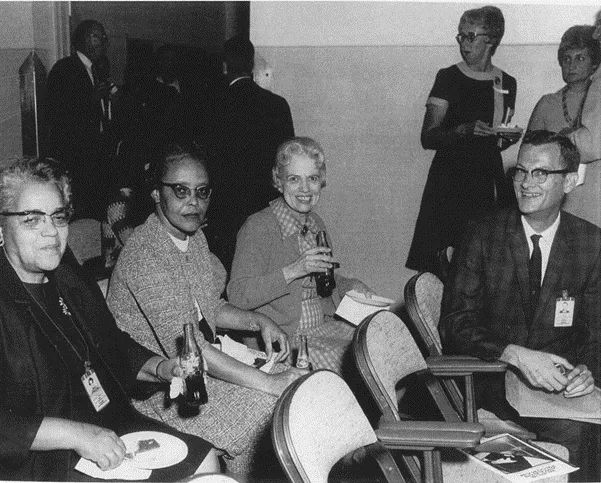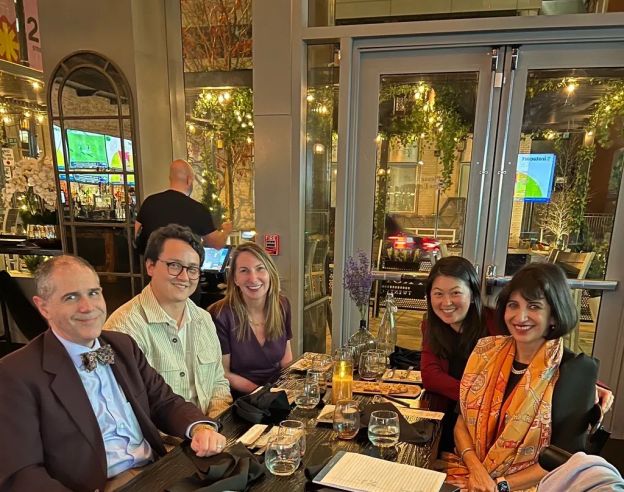- within Law Practice Management, Wealth Management and Insurance topic(s)

Ever since its founding by President Dwight D. Eisenhower in 1958, The U.S. National Aeronautics and Space Administration has been synonymous with exploration. Here are three heroic American explorers at their 1971 NASA retirement party: left to right, Dorothy Vaughan, Leslie Hunter, and Vivian Adair. Affectionately called by their colleagues "The Human Computers," the women were the inspiration for the best-selling book and blockbuster movie, Hidden Figures.
When I started practicing law in 1986, the tech boom was hitting Greater Washington. I met many entrepreneurs exploring ways to develop the next big thing. Health, management, information, infrastructure, all powered by some aspect of technology. It was a heady experience for a young associate in BigLaw to see these change-the-world idealists transforming how business and government operated.
I was attracted to their way of thinking, and started to consider how I, even at this early stage of my career, could build an immigration practice that would similarly make a difference. But because at that time I had such a limited sphere of experience, I turned to others for their ideas. My "ideation task force" included renowned business generators in my law firm, clients building up their businesses in the DC area, salespeople marketing everything from voice mail systems to cosmetics, and my family, who simply cared that I do well. The group was highly diverse, including seasoned operatives as well as newly-minted male and female entrepreneurs from all over the world. It was an exciting and eye-opening melting pot of demographics and mindsets, from Southeast Asia to Eastern Europe to Latin America.
The education and inspiration I received was extraordinary. For instance, one of the most successful females in BigLaw then and now told me I needed to get information to clients in a format that was easy to access and digest. Simplicity. The clients told me they valued lawyers who understood their business deeply and, therefore, gave advice that could be incorporated effectively. Pragmatism. The salespeople told me success depends on cultivating repeat business. Relationship building. And my family reminded me that I was a product of cross-cultural assimilation myself, since I spent many months of my childhood in Ecuador as part of my Quito-born father's diplomatic tours of duty. Authenticity.
Thirty-six years later, I'm still relying on these same principles. My most successful ideas have always stemmed from caring, diverse teams who are willing to listen to others and also share their varied experiences and points-of-view. I've learned that when you assemble people of different backgrounds, cultures, generations and mindsets, novel ideas are the inevitable outcome. As Frans Johansson, founder and CEO of The Medici Group (advisor to executives of some of the world's largest companies as well as startups), summed it up in a June 2020 blog post:
Ideas aren't created out of thin air. They're created by people-by teams of people. And the more diverse these teams are along many dimensions-culture, ethnicity, gender, sexuality, age, experience level, educational background, expertise, etc.-the more likely they are to draw inspiration from seemingly unrelated places. These idea combinations lead to more unlikely-and more innovative-ideas.
In last week's essay, GWU professor Joel Gehman discussed how 3M, consistently one of the world's most innovative companies, assembles teams from disparate parts of the company to energize product development, content marketing, and R&D. 3M encourages competing viewpoints, as summarized in "Lessons in Teamwork: the 3M Experience," which details how a cross-functional team delivered a first-of-its-kind gas/vapor/particle personal-filtering face mask.
Steve Jobs also knew that nothing stifled innovation more than GroupThink. So strongly did he feel that outside-the-box exploring was vital, he made "Think Different" the centerpiece of Apple's mission and brand, in contrast to IBM's "Think" marketing campaign. His insistence on creating highly diverse and competing R&D teams is what propelled Apple from the brink of bankruptcy to one of the world's most successful-and innovative-companies. Tony Faddell, father of the game-changing iPod, describes some of the alternative designs in a 2017 interview with Wired. And as for the hugely successful iPhone, one of its prototypes was based on a clickwheel iPod, still a revolutionary design concept, which reflects the inherent inventiveness of exploration via diversity.
One of the world's iconic consulting firms, Accenture, follows a similar script. For instance, in its 2019 annual report, "Getting to Equal" (based on its online survey of 18,000 employees in 27 countries, and phone interviews with 150 C-level executives in eight), Accenture found that an employee's innovation mindset (which it defined as "the willingness and ability to innovate") is nearly five times higher in companies with a robust culture of equality. Ellyn Shook, Accenture's chief leadership & human resources officer, added: "If people feel a sense of belonging and are valued by their employers for their unique contributions, perspectives and circumstances, they are more likely to advance and feel empowered to innovate."
A culture of full-spectrum equality breeds respect as it catalyzes innovation. Distinctive backgrounds, predilections, and perspectives facilitate the exploration of distinctive pathways, methods, and solutions. Absent such fresh thinking, the enterprise is likely to rely on dated formulas, ones that yielded success in previous times, but which are unlikely to reflect the changing trends that only a truly diverse population understands.
In my world, I know that the regulatory and economic playing field will change at least every two years, in response to the federal election cycle. Washington is on fire every two years; add a presidential term, and it's explosive. That's a time when strategic planning becomes essential. I rely on the same method I did as a young lawyer. I reach out and convene a team of trusted-and a few lesser-known-advisors from different backgrounds, perspectives and generations. I love the heterogeneous, imaginative responses when I ask "What's next?" to a 26-year old recent law school graduate, an Asian-American woman who has led successful practices in Greater China and the United States, a former journalist who was recently made a law firm partner, a former dignitary with the State Department, and a former leader of US Citizenship & Immigration Services whose prior posts include a stint with the US embassy in Moscow. The ricocheting ideas they come up with amaze me, ground me, humble me, and expand my horizon of possibilities. For instance, one of their current projects is a proprietary product that combines travel solutions with security protections.
So, to all the explorers out there, my advice is: surround yourself with a melting pot of smart, hard-working people who listen, evaluate, and, most of all, speak with authentic voices-and you can navigate the remotest galaxies and achieve almost anything. As we celebrate women's history month, I want to applaud the incredibly talented lawyers and business services staff that help me every day, and to encourage each to continue to lend her or his unique voice to answer the question: "What's next?"

One team of explorers that I rely on today to lead Mayer Brown's Global Mobility & Migration practice. Featured here at a "What's Next?" planning session we recently held in DC are Carl Risch (former US Assistant Secretary of State for Consular Affairs), Max Del Rey (once a journalist, now a partner), Morgan Bailey (former leader with US Citizenship & Immigration Services who also served at the US embassy in Moscow), Grace Shie (leader of immigration practices in Greater China and the United States), and yours truly.
Originally published by The Engine Under the Hood.
Visit us at mayerbrown.com
Mayer Brown is a global legal services provider comprising legal practices that are separate entities (the "Mayer Brown Practices"). The Mayer Brown Practices are: Mayer Brown LLP and Mayer Brown Europe - Brussels LLP, both limited liability partnerships established in Illinois USA; Mayer Brown International LLP, a limited liability partnership incorporated in England and Wales (authorized and regulated by the Solicitors Regulation Authority and registered in England and Wales number OC 303359); Mayer Brown, a SELAS established in France; Mayer Brown JSM, a Hong Kong partnership and its associated entities in Asia; and Tauil & Chequer Advogados, a Brazilian law partnership with which Mayer Brown is associated. "Mayer Brown" and the Mayer Brown logo are the trademarks of the Mayer Brown Practices in their respective jurisdictions.
© Copyright 2020. The Mayer Brown Practices. All rights reserved.
This Mayer Brown article provides information and comments on legal issues and developments of interest. The foregoing is not a comprehensive treatment of the subject matter covered and is not intended to provide legal advice. Readers should seek specific legal advice before taking any action with respect to the matters discussed herein.

